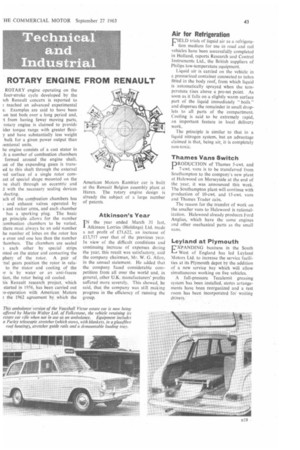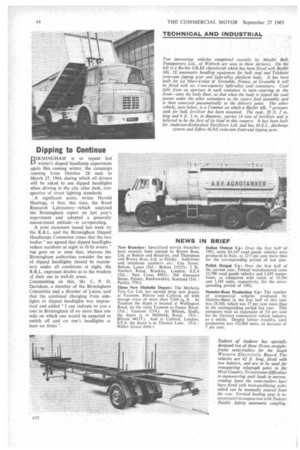ROTARY ENGINE FROM RENAULT
Page 47

Page 48

If you've noticed an error in this article please click here to report it so we can fix it.
ROTARY engine operating on the four-stroke cycle developed by the ich Renault concern is reported to !. reached an advanced experimental e. Examples are said to have been on test beds over a long period and, -t from having fewer moving parts, rotary engine is claimed to provide ider torque range with greater flexiy and have substantially less weight bulk for a given power output than rentional units. he engine consists of a cast stator in 11 a number of combustion chambers formed around the engine shaft ust of the expanding gases is transed to this shaft through the external !ed surface of a single rotor cornant of special shape mounted on the ne shaft through an eccentric and with the necessary sealing devices ducting. ich of the combustion chambers has . and exhaust valves operated by s and rocker arms, and each chamber has a sparking plug. The basic gn principle allows for the number :ombustion chambers to be varied, there must always be an odd number he number of lobes on the rotor has e even and one less than the number !hambers. The chambers are sealed each other by special strips inted on the stator and contacting the phery of the rotor. A pair of -nal gears position the rotor in relato the stator and cooling of the nis by water or an anti-freeze tion, the rotor being oil cooled. his Renault research project, which started in 1956, has been carried out !a-operation with American Motors the 1962 agreement by which the American Motors Rambler car is built at the Renault Belgian assembly plant at Haren. The rotary engine design is already the subject of a large number of patents.
Atkinson's Year IN the year ended March 31 last, Atkinson Lorries (Holdings) Ltd. made a net profit of £71,622, an increase of £13,717 over that of the previous year. In view of the difficult conditions and continuing increase of expenses during the year, this result was satisfactory, said the company chairman, Mr. W. G. Allen, in the annual statement. He added that the company faced considerable competition from all over the world and, in general, other U.K. manufacturers' profits suffered more severely. This showed, he said, that the company was still making progress in the efficiency of running the group. Air for Refrigeration E'1ELD trials of liquid air as a refrigera tion medium for use in road and rail vehicles have been successfully completed in Holland, reports Research and Control Instruments Ltd., the British suppliers of Philips low-temperature equipment. Liquid air is carried on the vehicle in a pressurized container connected to tubes fitted in the body roof, from which liquid is automatically sprayed when the temperature rises above a pre-set point. As soon as it falls on a slightly warm surface part of the liquid immediately " boils " and disperses the remainder in small droplets to all parts of the compartment. Cooling is said to be extremely rapid, an important feature in local delivery work.
The principle is similar to that in a liquid nitrogen system, but an advantage claimed is that, being air, it is completely non-toxic.
Thames Vans Switch PRODUCTION of Thames 5-cwt. and 7-cwt. vans is to be transferred from Southampton to the company's new plant at Halewood on Merseyside at the end of the year, it was announced this week. The Southampton plant will continue with production of 10-cwt. and 15-cwt. vans and Thames Trader cabs. The reason for the transfer of work on the smaller vans to Halewood is rationalization. Halewood already produces Ford Anglias, which have the same engines and other mechanical parts as the small vans.
Leyland at Plymouth EXPANDING business in the South 1-4 West of England has led Leyland Motors Ltd. to increase the service facilities at its Plymouth depot by the addition of a new service bay which will allow simultaneous working on five vehicles. A full-pressure Tecalemit greasing system has been installed, stores arrangements have been reorganized and a rest room has been incorporated for waiting drivers.
Dipping to Continue
D1RMINGHAM is to repeat last
winter's dipped headlamp experiment again this coming winter, the campaign running from October 28 next to March 27, 1964, during which all drivers will be asked to use dipped headlights when driving in the city after dark, irrespective of street lighting standards.
A significant point, writes Harold Hastings, is that, this time, the Road Research Laboratory—which analysed the Birmingham report on last year's experiment and adopted a generally unconvinced attitude—is co-operating.
A joint statement issued last week by the R.R.L. and the Birmingham Dipped Headlamps Committee states that the two bodies " are agreed that dipped headlights reduce accidents at night in streets" but goes on to slate that, whereas the Birmingham authorities consider the use of dipped headlights should be mandatory under all conditions at night, 'he R.R.L. expresses doubts as to the wisdom of their use in well-lit areas.
Commenting on this, Mr. C. P. D. Davidson, a member of the Birmingham Committee and a director of Lucas, said that the continual changing from sidelights to dipped headlights was impractical and added "I can indicate to you a tour in Birmingham of no more than one mile on which one would be expected to switch off and on one's headlights at least six times ".






















































































































